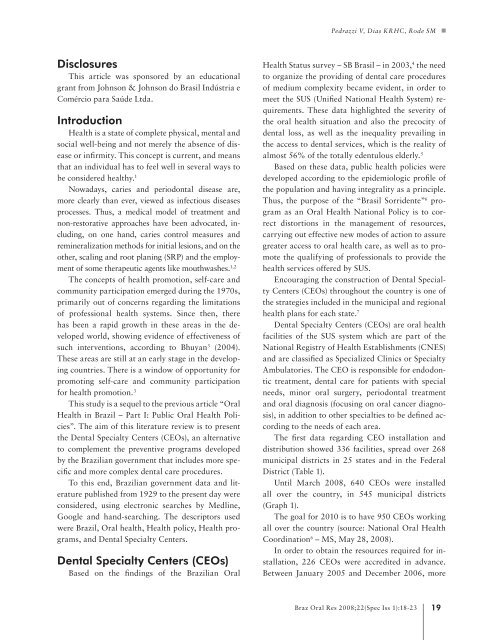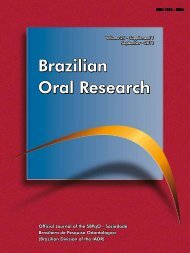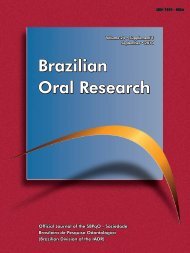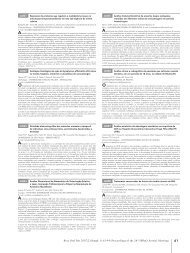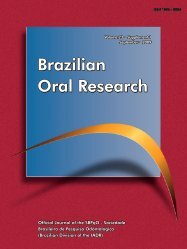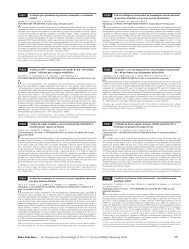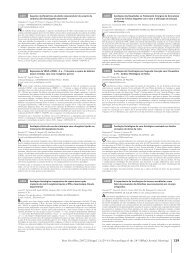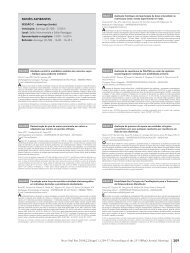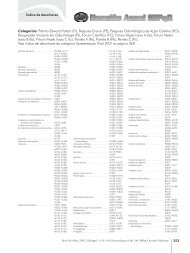Brazilian Oral Research Brazilian Oral Research Brazilian Oral
Brazilian Oral Research Brazilian Oral Research Brazilian Oral
Brazilian Oral Research Brazilian Oral Research Brazilian Oral
Create successful ePaper yourself
Turn your PDF publications into a flip-book with our unique Google optimized e-Paper software.
Disclosures<br />
This article was sponsored by an educational<br />
grant from Johnson & Johnson do Brasil Indústria e<br />
Comércio para Saúde Ltda.<br />
Introduction<br />
Health is a state of complete physical, mental and<br />
social well-being and not merely the absence of disease<br />
or infirmity. This concept is current, and means<br />
that an individual has to feel well in several ways to<br />
be considered healthy. 1<br />
Nowadays, caries and periodontal disease are,<br />
more clearly than ever, viewed as infectious diseases<br />
processes. Thus, a medical model of treatment and<br />
non-restorative approaches have been advocated, including,<br />
on one hand, caries control measures and<br />
remineralization methods for initial lesions, and on the<br />
other, scaling and root planing (SRP) and the employment<br />
of some therapeutic agents like mouthwashes. 1,2<br />
The concepts of health promotion, self-care and<br />
community participation emerged during the 1970s,<br />
primarily out of concerns regarding the limitations<br />
of professional health systems. Since then, there<br />
has been a rapid growth in these areas in the developed<br />
world, showing evidence of effectiveness of<br />
such interventions, according to Bhuyan 3 (2004).<br />
These areas are still at an early stage in the developing<br />
countries. There is a window of opportunity for<br />
promoting self-care and community participation<br />
for health promotion. 3<br />
This study is a sequel to the previous article “<strong>Oral</strong><br />
Health in Brazil – Part I: Public <strong>Oral</strong> Health Policies”.<br />
The aim of this literature review is to present<br />
the Dental Specialty Centers (CEOs), an alternative<br />
to complement the preventive programs developed<br />
by the <strong>Brazilian</strong> government that includes more specific<br />
and more complex dental care procedures.<br />
To this end, <strong>Brazilian</strong> government data and literature<br />
published from 1929 to the present day were<br />
considered, using electronic searches by Medline,<br />
Google and hand-searching. The descriptors used<br />
were Brazil, <strong>Oral</strong> health, Health policy, Health programs,<br />
and Dental Specialty Centers.<br />
Dental Specialty Centers (CEOs)<br />
Based on the findings of the <strong>Brazilian</strong> <strong>Oral</strong><br />
Pedrazzi V, Dias KRHC, Rode SM<br />
Health Status survey – SB Brasil – in 2003, 4 the need<br />
to organize the providing of dental care procedures<br />
of medium complexity became evident, in order to<br />
meet the SUS (Unified National Health System) requirements.<br />
These data highlighted the severity of<br />
the oral health situation and also the precocity of<br />
dental loss, as well as the inequality prevailing in<br />
the access to dental services, which is the reality of<br />
almost 56% of the totally edentulous elderly. 5<br />
Based on these data, public health policies were<br />
developed according to the epidemiologic profile of<br />
the population and having integrality as a principle.<br />
Thus, the purpose of the “Brasil Sorridente” 6 program<br />
as an <strong>Oral</strong> Health National Policy is to correct<br />
distortions in the management of resources,<br />
carrying out effective new modes of action to assure<br />
greater access to oral health care, as well as to promote<br />
the qualifying of professionals to provide the<br />
health services offered by SUS.<br />
Encouraging the construction of Dental Specialty<br />
Centers (CEOs) throughout the country is one of<br />
the strategies included in the municipal and regional<br />
health plans for each state. 7<br />
Dental Specialty Centers (CEOs) are oral health<br />
facilities of the SUS system which are part of the<br />
National Registry of Health Establishments (CNES)<br />
and are classified as Specialized Clinics or Specialty<br />
Ambulatories. The CEO is responsible for endodontic<br />
treatment, dental care for patients with special<br />
needs, minor oral surgery, periodontal treatment<br />
and oral diagnosis (focusing on oral cancer diagnosis),<br />
in addition to other specialties to be defined according<br />
to the needs of each area.<br />
The first data regarding CEO installation and<br />
distribution showed 336 facilities, spread over 268<br />
municipal districts in 25 states and in the Federal<br />
District (Table 1).<br />
Until March 2008, 640 CEOs were installed<br />
all over the country, in 545 municipal districts<br />
(Graph 1).<br />
The goal for 2010 is to have 950 CEOs working<br />
all over the country (source: National <strong>Oral</strong> Health<br />
Coordination 6 – MS, May 28, 2008).<br />
In order to obtain the resources required for installation,<br />
226 CEOs were accredited in advance.<br />
Between January 2005 and December 2006, more<br />
Braz <strong>Oral</strong> Res 2008;22(Spec Iss 1):18-23 1


